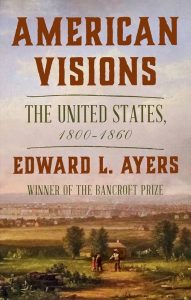Book Review: American Visions: The United States, 1800-1860

 American Visions: The United States, 1800-1860. By Edward L. Ayers. New York: W.W. Norton and Company, 2023. Hardcover, 368 pp. $32.50.
American Visions: The United States, 1800-1860. By Edward L. Ayers. New York: W.W. Norton and Company, 2023. Hardcover, 368 pp. $32.50.
Reviewed by Evan Clapsaddle
In American Visions, Edward Ayers presents a young America trying to find its identity while emerging from its founding era into an unknown and uncertain future. Progressing through the years 1800-1860, Ayers discusses how our country created a uniquely American identity through commercial pursuits, artistic and literary endeavors, as well as social and spiritual movements. These cultural outlets held potential ramifications related to the politics of slavery and territorial expansion.
Thoroughly researched and well-documented, American Visions argues that powerful political forces worked diligently to reinforce the tenets of manifest destiny and a shaky equilibrium regarding slavery. Simultaneously, others challenged these norms by social, religious, artistic, literary, and technological means. Ayers introduces us to figures that pushed traditional accepted boundaries of what it meant to be an American. Some of the figures Ayres profiles are familiar to many: Ralph Waldo Emerson, Elizabeth Cady Stanton, Frederick Douglas, Edgar Allen Poe, and P.T. Barnum. Others are perhaps less well known: Elias Boudinot, John Chapman, and Louis Agassiz. In doing so, he reveals the myriad contemporary visions of what America was and what it could be.
Activist movements and their relation to societal norms are a major theme of the book. Women’s rights, abolitionism, transcendentalism, and capitalism are brought together in this narrative. Ayers shows how these movements developed in early America and explains that as these social, political, religious, and economic crusades strengthened over time, their interconnections and resulting tensions sometimes weakened their overall impact.
Ayers uses the art, writing, and social movements of Antebellum America to reflect on the institution of slavery. He discusses the tensions around slavery not through politics but with the writers and activists of the age. We see how public speakers like Frederick Douglass and Sojourner Truth, among others, spoke out against the evils of slavery at home and abroad. We learn how writers like Harriet Beecher Stowe, Hinton Rowan Helper, and Frederick Law Olmstead portrayed the detrimental effects of a slave-based socio-economic system. Ayers shows us that these anti-slavery voices maintained a shaky alliance with other social reform movements while simultaneously arousing the anger of Southerners eager to defend slavery and the virtues they perceived in the institution.
A strength of American Visions is that it challenges, to some degree, the notion that it was only through the institution of slavery and the Civil War that we identified who we were as a nation. Ayers writes that “an expectation of change defined America’s vision of itself . . . the United States became a land of perpetual becoming.” (58)
American Visions is a needed addition to Antebellum-era historiography. It provides valuable insights into the multiple people, voices, and ideas that contributed to American identity in the early 1800s. While many volumes rightly address sectional tensions of the time fueled by arguments about slavery and territorial expansion, Ayers provides another lens through which to view the widening chasm between North and South and the fractures within the ideologies of both regions. While slavery and sectional economic differences receive most of the attention from students and scholars who study the antebellum period, Ayres wisely shows that examining other viewpoints can provide us additional information about the societal fabric of a young America. Burgeoning literary forms, technological and educational innovations, emerging religious interpretations, and various social movements also helped contribute to sectionalism at that time.
Our conception of American culture and society during the Civil War years and beyond is incomplete without a thorough understanding of antebellum norms and how they were challenged. Ayers writes an informative narrative about an evolving America using the vibrant personalities, ideas, and works of a dynamic nation. American Visions provides a solid foundation for understanding the social complexity of forming a national identity and the regional tension that increased in creating that identity.
Evan Clapsaddle lives in Cherokee, North Carolina with his wife (Annette) and two sons (Ross and Charlie). He is an educator of 22 years with Bachelor’s and Master’s degrees in American history and secondary education. His favorite research topics include Gettysburg’s first day and Chickamauga. He loves road-tripping in search of Civil War sites, the perfect pretzel, and quality libations.